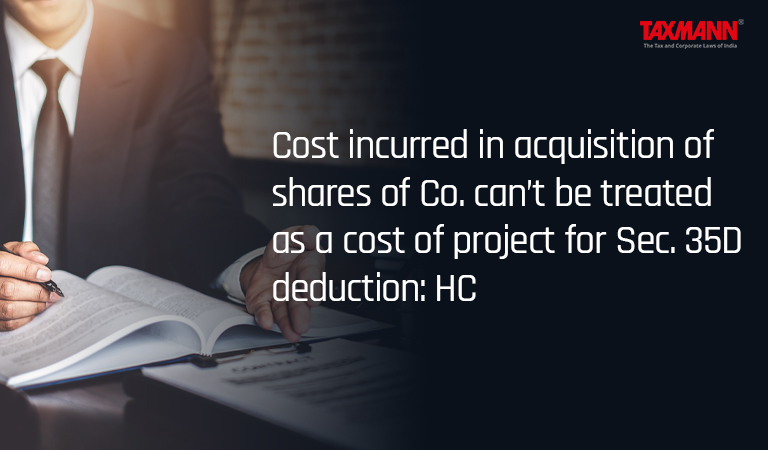Cost incurred in acquisition of shares of Co. can’t be treated as a cost of project for Sec. 35D deduction: HC
- Blog|News|Income Tax|
- 2 Min Read
- By Taxmann
- |
- Last Updated on 12 November, 2021
Case Details: Subex Ltd. v. CIT - [2021] 132 taxmann.com 96 (Karnataka)
Judiciary and Counsel Details
-
- Mrs. S. Sujatha and Ravi V. Hosmani, JJ.
- K.K. Chythanya, Adv. for the Appellant.
- Jeevan J. Neeralgi, T.N.C. Sridhar and K.V. Aravind, Advs. for the Respondent.
Facts of the Case
Section 35D(3) provides for the qualifying amount which shall be eligible for deduction as preliminary expenditure. Such qualifying amount is lower of actual preliminary expenditure incurred on specified items or 5% of the cost of the project, in case of non-corporate assessee. However, in the case of an Indian company, the qualifying amount shall be lower of actual preliminary expenditure incurred on specified items or 5% of cost of project (or 5% of capital employed, at the option of the assessee).
Further, the Explanation (a)(ii) to section 35D provides that cost of project means the actual cost of fixed assets being land buildings, leaseholds, plant, machinery, furniture, fittings, railway sidings, and expenditure on development of lands and buildings.
The issue before the Karnataka High Court was:
‘Whether the Tribunal was right in law in holding that the cost of acquisition of companies cannot be treated as asset for allowing deduction under section 35D of the Income-tax Act?’
Assessee claimed that it has acquired two companies and acquisition of 100% subsidiary shares of such two companies has to be construed as cost of project. Referring to section 35D, assessee contended that cost of project could be acquired by two methods. Firstly, by acquiring the assets individually and secondly, acquiring 100% subsidiary shares.
On contrary, the Assessing Officer (AO) submitted that the shareholder is not the owner of the fixed asset. The phrase ‘being’ has to be interpreted as exhaustive, i.e., which are in the nature of fixed assets, namely land, building, leaseholds, plant, machinery, etc. which are shown in the books of assessee on the last day of the previous year. In the given case, assessee hadn’t acquired any fixed assets.
High Court Held
The Karnataka High Court has concurred with the ruling of the Hon’ble Madras High Court in the case of Ashok Leyland Ltd. [2012] 23 taxmann.com 50 (Madras). The Madras High Court has considered the meaning of the phrase ‘being’ and declared that the expenditure that qualified for consideration under section 35D is restricted by reason of use of phrase ‘being’.
The Karnataka High Court held that the word ‘being’ gets colour from the associated words. The preceding word ‘fixed assets’ indicated as land, building, leaseholds, plant machinery relates to the nature of assets mentioned therein, and the same is exhaustive.
Accordingly, acquisition of companies by acquiring 100% subsidiary shares would not be constructed as the acquisition of the fixed assets that were acquired or developed in connection with the extension of industrial undertaking or setting up of new industrial unit of assessee.
Disclaimer: The content/information published on the website is only for general information of the user and shall not be construed as legal advice. While the Taxmann has exercised reasonable efforts to ensure the veracity of information/content published, Taxmann shall be under no liability in any manner whatsoever for incorrect information, if any.

Taxmann Publications has a dedicated in-house Research & Editorial Team. This team consists of a team of Chartered Accountants, Company Secretaries, and Lawyers. This team works under the guidance and supervision of editor-in-chief Mr Rakesh Bhargava.
The Research and Editorial Team is responsible for developing reliable and accurate content for the readers. The team follows the six-sigma approach to achieve the benchmark of zero error in its publications and research platforms. The team ensures that the following publication guidelines are thoroughly followed while developing the content:
- The statutory material is obtained only from the authorized and reliable sources
- All the latest developments in the judicial and legislative fields are covered
- Prepare the analytical write-ups on current, controversial, and important issues to help the readers to understand the concept and its implications
- Every content published by Taxmann is complete, accurate and lucid
- All evidence-based statements are supported with proper reference to Section, Circular No., Notification No. or citations
- The golden rules of grammar, style and consistency are thoroughly followed
- Font and size that’s easy to read and remain consistent across all imprint and digital publications are applied








